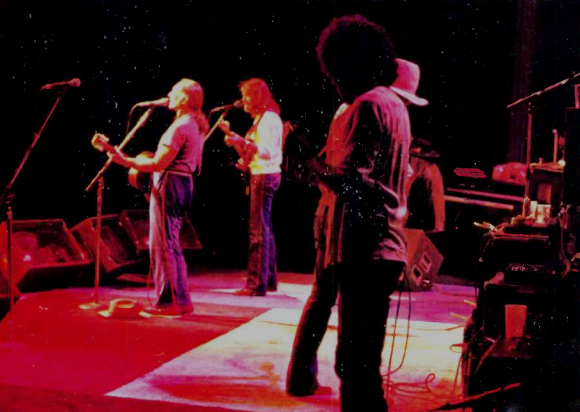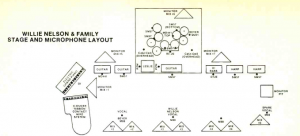It is perhaps safe to say that the Willie Nelson organization has been spending more production dollars for sound and lighting than most other country-oriented acts.
Nelson’s house mix engineer, Mike Garvey, of Dallas, Texas, explains hie part in the decision-making process when it came down to choosing a sound system for the tour:
“It’s not as if I have a blank check or anything, but I was given the authority to go with the best. We are using Innovative Audio to provide us with Gamble consoles and electronics and stage monitors; the main house speaker system is from Showco.
“I could not find everything I wanted from one company, so we ended up with two. It is an unfortunate situation to split it up like that, but I have a commitment to Willie to give him the best I can find, and that is how it has worked out.”
Showco House Speaker System
Garvey feels that Willie Nelson’s touring requirements are a bit unusual, when compared to “typical” concert tours — if such a thing exists.
“We aren’t like Van Halen or somebody like that, where you play the same kind of venue in every city you do,” he offers. “We play an extremely wide variety of places. We might be in a little-bitty club with 150 people one night, and be looking at 50,000 folks outdoors the next day. I needed a speaker system that could handle anything.”
“A lot of the available systems are either good for short-throw, wide dispersion situations, or else they are set up to be a long-throw system and end up being very ‘beamy.’ I need something very versatile. And, doing a show which is primarily vocals, I need to get those mids and highs all the way to the back of the hall really get that articulation out there. The Showco pyramid system is one I am really confident in, and have had a lot of experience with. ”
Garvey, a former Showco employee, has a particular preference for the Showco method of stacking the mid-range horns inside the cabinets, and also is pleased with the low-frequency projection. “The pyramid box is actually a vented horn-loaded box… it has a 10-inch port. You get the best of both horn-loading and reflex action,” he claims.
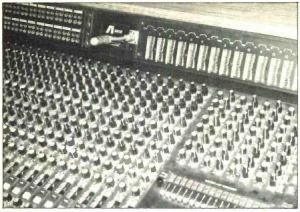
Innovative Audio’s Front End
The choice of Innovative Audio came about largely due to the company’s reputation as a reliable supplier of consoles manufactured by Jim Gamble Associates. Rapidly becoming the favorite of many experienced concert sound engineers, Gamble custom-built consoles are quite popular due to their many utilitarian features, and excellent sonic quality.
But why did Garvey go out of his way to hire a separate sound company just to gain access to a Gamble board? “There are a whole bunch of reasons!” he recalls. “It is really clean . . . it seems to be a real bright sounding board. To my ears, the console seems to have a different sound to it . . . a ‘faster,’ cleaner sound; it sounds better than any other console I have ever used. And, there is the built-in spectrum analyzer, onboard graphics, and so on.
“The graphic is the cleanest I have ever used . . . if I go even 3 dB up or down on a given frequency, I figure that something is wrong somewhere else. And the console is really reliable. In two years, I have only had a couple of failures . and one of them wasn’t the board’s fault; some guy threw a beer on the board!”
Innovative Audio’s David Morgan echoes Garvey’s comments about the Gamble console’s reliability: “This board you are looking at has probably done about 1,500 shows. We have eight of these available to us, and very rarely have any down-time.”
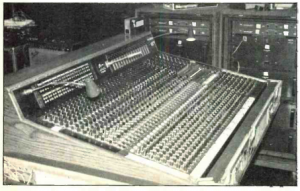
Morgan says that the consoles were designed with easy field servicing in mind. “The modular panels are quickly and easily removed. And you can find many of the circuit board components at any Radio Shack. But don’t get me wrong, there’s some expensive stuff in there. The capacitors are Sprague-type solid tantalum; the resistors are Allen-Bradley 1% tolerance. It all adds up to a -130 dBv equivalent input noise signal ratio.”
Innovative’s consoles have been modified somewhat. “We work with a gentleman named Dirk Schubert,” Morgan explains. “He, in conjunction with our company, has taken the Gamble board and made it only the beginning of what we feel is the cleanest concert audio system available.
“As far as I know, Innovative can field the only fully transformerless, DC-coupled PA system in the world. There are no audio transformers anywhere in the signal chain, except for those in the microphones themselves. We do it all with BIFET active-balanced circuits, and the circuits are the proprietary designs of Innovative Audio, Dirk Schubert, and Jim Gamble.”
Morgan claims that this circuitry enables the system to produce a guaranteed maximum of 5% phase distortion throughout the entire chain, measurable at any point in the system from the mike input to the crossover output. (Typically, an audio frequency amplification system will have a measurable phase distortion of between 5% and 40% at some point in the signal path).
“The combination of the Gamble consoles and our own crossovers [18 dB Thompson-Bessel minimum-delay, equal-phase-shift filters] give us an extremely transparent system,” Morgan continues. “We use more chips, more integrated circuit amplifiers, than any other company would use transformers. Each Gamble console has over 1,600 ICs, and then we pass it through all active-balanced circuitry, down the snake, and into our amp racks, each of which has our own active-balanced line amplifier built into it. This way, each amplifier channel ‘sees’ the same signal level, and we eliminate any damping errors, rather than trying to cut the same-length speaker wire or whatever, like other people struggle with.”
House Mix
For the Willie Nelson tour, Mike Garvey’e house mix was taken from the Gamble HC40-24 40-input console and sent through the Showco equipment rack, which contained two Showco four-way electronic crossovers, and dbx Model 165 compressor-limiters.
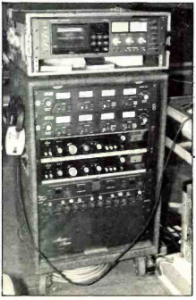
The stereo mix utilized only two of the console’s 16 main outputs, while two more were used to feed a stereo cassette tape deck for recording show mixes. Garvey used one of the eight effects busses to drive a MICMIX Master-Room rack-mount spring reverb unit.
“This is a real bare-bones, straight ahead approach to mixing,” Garvey offers. “That reverb unit is my only effects device for signal processing; I don’t use any pitch shifters or delays, or stuff like that. That new Master-Room, Model 515 1 think it is, has a really good plate sound to it, and it allows me to get Willie’s voice sounding just like the record on things like ‘You Were Always On My Mind.’
“But I am not into cluttering up the sound of Willie and the band with a bunch of garbage. As far as we are concerned, if people come to the show and can hear the words at the back of the arena, and leave knowing they saw Willie and had a good time, then we have done our job.”
When this writer pointed out the obvious lack of outboard equalization in Garvey’s house rack, he stressed that the Gamble console’s onboard third-octave graphics were completely adequate.
“I just plain do not need anything else on it,” he says. “Used to be that only cheap music-store boards had a built-in graphic on them, but this one is really hot. It is extremely accurate, and is right there near my master faders where I need it.”
According to the console’s designer and builder, Jim Gamble, these two graphics are normaled to the stereo main outputs. “Every fourth slider is summed together, and those groups are then cascaded,” he explains. “So, the net result is that if you pull up one fader all the way, you get 12 dB of system gain at that frequency. Pull up the adjacent fader, and you don’t just have unity gain, you have another 12 dB. The units are capable of pulverizing any speaker system you might happen to be using if you’re not careful.”
Garvey was using 30 of his available input channels on the Gamble HC40-24 console. “We have a couple of spare mikes up there, in addition to all of the stage instruments,” he remarks.
“I also run a lot of the instruments in stereo, and use three channels for the harmonica; and the acoustic piano takes up two channels. And we have 14 mikes on the drum set alone.”
He considers that, even in large arenas, it was worth the trouble to run the sound system in stereo: “A lot of engineers feel that it is foolish to try to produce stereo effects in a live setting, but I can really get a good stereo imaging effect. Of course, the folks off to the far sides may not get it all, but it does give an added dimension to the sound of the show.” Garvey pans the entire drum set for a live stereo effect, in addition to the other instruments.
Much of the praise he often receives for Willie Nelson’s unique sound is undeserved, Garvey feels. “Heck, Willie would sound good singing in a bathtub. He has a very clear voice that always carries well anywhere. Sometimes, when we play large, boomy halls with other acts, people complain all night that they cannot understand the words. Then, when Willie walks out, they wonder who fixed the PA system . . . but, it’s not me; it’s really him.
“Willie has a really powerful set of lungs, and if I don’t tweak out the system just right in the upper mid-range section, he’ll hit a few notes that just plain destroy the horn diaphragms. He spent a lot of years singing without any sound system at all, and he can sometimes just peg those meters right over with no effort at all. And that old Martin guitar he’s been using for years has a very distinctive tone. We just stick a mike in front of the old Baldwin amplifier, get the EQ flat on the input channel, and it comes out sounding great.”
Garvey explains that Nelson’s Martin guitar is equipped with a stereo pickup, and the Baldwin amplifier is stereo: one side gets the highs, and the other the lows.
Stage Miking
For this tour Willie Nelson’s band consisted of a drummer, bass guitarist, two electric/ acoustic guitarists, along with Willie’s sister on piano, and the infamous Mickey Raphael on harmonica.
Drummer Paul English sported a rather large set with six rack toms, and much peripheral percussion. The kick drum was miked with an Electro-Voice RE-20, and the toms were covered with Shure SM57s. The snare drum was miked on top with a Sennheiser 441, and on the bottom with an SM57. A pair of AKG C45-CK88 were suspended above the set for overhead mikes, and a C451-CKI positioned near the bell tree and bongos (Figure 4).
Electric guitar amplifiers were given SM57s or Sennheiser 4418. Bass guitar was taken as a direct input, and also miked with an AKG D12E. The acoustic grand piano had two C’Ducer pickup elements permanently mounted under the sound board, which saves time during setup. “We just leave those pickup strips in there all the time,” remarks Pete Stauber, a stage instrument technician and monitor mixer for Nelson and the band. “A lot of people mess with [contact mikes], and other messy types of pickups, but this is the way to go. The C’Ducer has a thin, strip-like element, and can stay in the piano during cartage.”
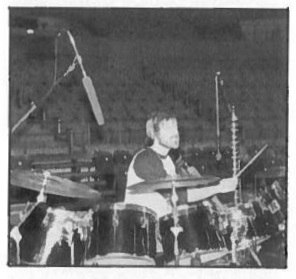
For vocals, Innovative Audio’s Gordon Jennings had put out Beyer M88s. Nelson, however, was singing through an AKG D330. “It’s one we tried out last year that Willie really liked,” Jennings says. “He likes the way it sounds, and it seems to be able to take the high sound pressure levels pretty well. It’s also very good in the monitors; due to its tight cardioid pattern, it seems to have good feedback rejection characteristics.”
One novel piece of stage gear that hag a unique sound is the Fender Leslie Model 18 used by guitarist Jody Paine. His electric guitar signal was sent through the Leslie cabinet, which had a Crown PZM suspended over the grillcloth on either side of the cabinet. AB the sound of the guitar “rotated,” the two PZMB on opposing sides were panned left and right, respectively, at the house console, which resulted in a very interesting effect in the audience area.
Another interesting item of gear was Mickey Raphael’s wireless harmonica set-up: a Shure 545 fed into a Nady BeltPack system (the 700/800 VHF model), which enabled the musician to have free run of the stage area. The wireless receiver was then fed into a Fender Super-Reverb amplifier miked with a Shure SM57.

